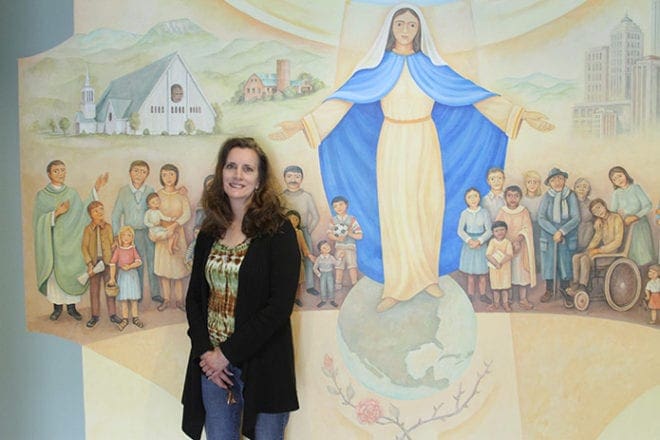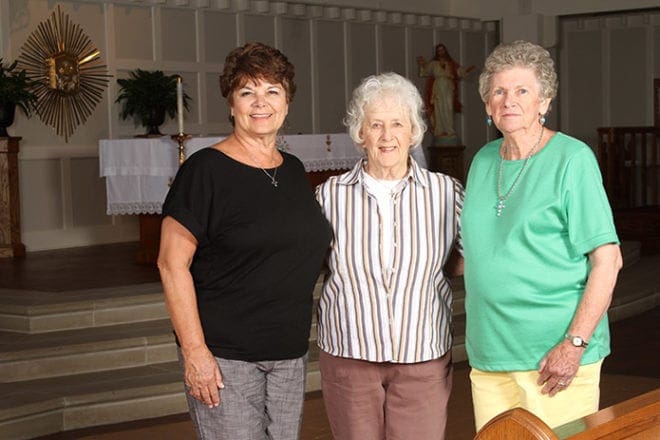 Photo By Michael Alexander
Photo By Michael Alexander Cleveland
Jubilee year for St. Paul the Apostle, center of enduring faith for White County Catholics
By ANDREW NELSON, Staff Writer | Published July 24, 2014
CLEVELAND—Father Frank Ruff never wanted to waste a visit to a store.
Meeting folks in restaurants and drug stores for any excuse to chat was all in a day’s work for this priest. It was 1963 in rural White County. There were fewer Catholics here than fingers on his hands.
“If I needed stuff, I wouldn’t buy both the toothpaste and the toothbrush in the same drug store. That’s wasting a contact. So you buy a toothpaste in one and toothbrush in the other,” Father Ruff said, speaking on the telephone from his Kentucky home. “That way you get to talk to several people.”
Father Ruff is 78. He retired as a church pastor but still celebrates Mass and other duties at two parishes. He is a member of the Glenmary Home Missioners society, which serves in rural America where Catholics are few in number. The lilt in his voice from being raised on a northern Wisconsin dairy farm gave him away in north Georgia, as an outsider, as much as his white Roman collar.
“As soon as I opened my mouth, I was an oddball, an outsider,” said Father Ruff. “Most people had never met a Catholic. Some service people in World War II said, ‘I served with a Catholic.’”
The best advice he heard in his early days was to “just go over and visit and mosey around, get to know the community, find out how many Catholics are there.” And that’s what Father Ruff did. “It was wisdom beyond my ability,” he said, laughing.
Just a year after his ordination, he put down the foundation for what would become St. Paul the Apostle Church.
From seven people to 350 families
The parish, about 80 miles north of Atlanta, this July marked its 50th anniversary. The community was transferred from the care of Glenmary priests to become a diocesan mission in 1992. It became a parish in 2005, the same year its white A-frame church was built. In its entryway, a scorched altar cloth is framed behind glass. It was saved from a 2004 fire that destroyed a 20-year-old church building.
On the highway to the mountains and state parks, the parish no longer depends on visitors to fill its pews. Its nearly 350 registered families include those who worship in Spanish and in English.
In Father Ruff’s time, he met with other Christian leaders and started an ecumenical youth program to build bridges with other Christian churches when Catholics were few in number. However, now the parish members serve others in need without any thought about faith affiliation.
Regularly, dozens of men and women fill grocery bags at the parish food bank to help struggling families.
Other volunteers unpack a truck loaded with some 10,000 pounds of food. The truck from the Food Bank of Northeast Georgia stops here monthly.
“You see all walks. We have elderly, we have young ones, people that are down and need a little bit of a boost,” said Joyce Shakespeare, a leader of the effort of some 40 volunteers.
“With the prices of groceries, this might keep the electricity on,” she said of the hard choices people face.
She and her husband, Jim, joined the parish in 2008. St. Paul Church was a change from their much larger Tampa, Florida, parish.
“This is a small, very nice, very friendly (place). Ask and they are on it,” she said about her volunteers.
This ministry mirrors their work at their former church. Service and faith are tied together for her.
“They go hand in hand. If you can’t help someone, what’s the point of having faith? That’s what Jesus tells us to do. You are your brother’s keeper,” said Shakespeare, 68, a retired courthouse administrator.
The Mobile Food Bank Ministry helps as many as 200 families in a county where 17 percent of the residents live below the poverty line. The food is reserved for families from White County, but Shakespeare said anyone from outside the county receives food purchased by the parish.
“We will not let anyone go hungry,” she said.
The parish center’s doors are often unlocked before the scheduled noon opening to give people relief from humidity and the heat. Shakespeare’s voice carries a stern tone when she talks about the client families and how they are to be welcomed.
“I want all of them treated with respect and dignity. I don’t want anyone looking down on anybody. They even give us hugs. I don’t want anybody to shy away from that,” she said.
Hispanic ministry makes an impact
Every Sunday, crowds fill the parish center for tacos, tamales and pambazo, bread dipped in pepper sauce and stuffed with potatoes and meat. This food festival is hosted by the Hispanic community and brings in money to pay for the new education building. It is served weekly after the Spanish Mass and is now a monthly event after the English Mass so everyone can enjoy the food, said Lucia Moguel, a 47-year-old mother of four with Mexican roots.
The number of Hispanics in White County remains small, just a bit more than 2 percent of the population in 2012. But the estimated 660 people of Hispanic origin double the number recorded by the Census Bureau in 2000. And the rising number of Spanish-speakers fills the pews at St. Paul the Apostle Church.
Juan Gutierrez, 38, is an adult altar server, in addition to having been a reader at Mass.
“It’s like my home. That’s how I feel. I feel at peace,” he said.

Susan Hage has been teaching religious education for over 10 years, and for the last 6 years she has been teaching the confirmation class. Photo By Michael Alexander
Moguel, who recently celebrated her 25th wedding anniversary, has watched the community grow to standing-room-only at the Sunday Spanish Mass.
“You have to get there early or you don’t get a seat,” said Moguel, who creates customs drapes from her home. She’s been a member of the parish for nine years since her family moved from California.
She said the Hispanic community isn’t “strong in money, but we are strong in working.” The community hosts a one-day festival in the spring around the Cinco de Mayo holiday that brings in thousands of dollars, she said. People pitch in to help the parish, she said.
“We are trying and doing our best and are here to stay,” she said.
Susan Hage leads the confirmation program. She is 55, a native of South Carolina who wears a brown Our Lady of Mount Carmel scapular around her neck. Hage said three-quarters of her teenaged students speak Spanish. To share the faith with the teenagers’ parents, the parish buys bilingual religious lesson books. “It’s always evolving,” she said about the parish.
Families gather at “a unique and special place”
The first Mass in Cleveland was celebrated at Ward’s Funeral Home. A photo of the historic event shows a small group, but most were from someplace else. A black and white photo from July 5, 1964 in the parish scrapbook shows nearly 20 women in hats, men in ties, and girls carrying purses. Father Ruff chuckled telling the story: his priest friend in Dahlonega told a few parishioners there and in Gainesville to travel to Cleveland to fill the seats so Father Ruff wouldn’t get discouraged.
Community pressure a month later forced the Catholics to move. A building near the city square became the new chapel.
“We could set up 24 folding chairs and we didn’t fill it,” Father Ruff said.
Yet the pioneer Catholics created a community that would draw people to it.
Donna Galbiati felt drawn to this church community. It was the early 1980s; she and her husband were raising a family and wanted to move out of Florida. They liked this area with its hiking and camping, but didn’t have their heart set on a new home yet. In 1981 they attended Easter Mass at St Paul Church.
“We saw this little church, which was a tiny little house. In 1981, there were about 25 families. The people were just so welcoming. St. Paul made such an impression on us that made our decision,” she said.

St. Paul the Apostle Church parishioners (l-r) Donna Galbiati, Millie Dettman and Carol Quinn have been members of the parish since 1981, 1975 and 1971, respectively. Photo By Michael Alexander
That spring, she resigned her teaching position and the family of four moved to the area. A third Galbiati child was born here. Donna, the parish historian among other ministries she has served, and her husband, Peter, own Gabby’s Country Cabins, a 10-cabin vacation destination.
“It was the most welcoming thing we’ve ever felt. Immediately we were welcomed into this small community,” she said.
Three generations worship at the church now after her grandchildren were baptized there.
A fire in 2004 destroyed a 20-year-old church. She recalled how the community chose to worship during the summer heat under a large tent on the property so everyone could pray together.
“I’ve always said St. Paul is a magical corner. Mystical might be a better word. It’s always been a unique and special place. It’s an amazing place,” she said.
Galbiati’s story is shared by others. Carol Quinn moved here in 1971. Her children were baptized at the Methodist Church when Catholics gathered there for Mass.
“They were good to us,” Quinn said.
With few Catholics living in White County, in those days it was a tight-knit community, which was nice for the Quinns, who left their family back in their native New Jersey.
“Our social life was our church. It was family,” said Quinn, 72, silver-haired and wearing a matching turquoise cross and earrings. “We’ve grown and we’re proud we have a church.”
Today, Quinn, a widow, watches her grandchildren as altar servers.
Fifty years later, vibrancy in the diversity
Fifty years ago, Father Ruff worked to make inroads. He adopted some Protestant customs, for example, calling the faith community at first the Cleveland Catholic Chapel. Protestants name a church after the community, he said, so that’s what he did to make it familiar sounding.
His goal when he arrived was to help the whole community in “their following of the Gospel,” he said.
“I loved it. There were some lonely times, no doubt. When it came time for a new assignment, it was as hard as nails to leave,” he said.
He stepped down as pastor in 1969 and served as Catholic liaison to the Southern Baptist Convention, breaking ground in ecumenism, a passion that has continued throughout his priesthood. He also became the president of Glenmary Home Missioners. Attending the golden anniversary Mass on July 5, 2014, brought Father Ruff back to the parish he helped to start.
“I was rejoicing,” he said, about the vibrancy of the parish, as choirs sang hymns in Spanish and English and the community prayed together. “They have a very close community. It was beautiful.”
St. Paul the Apostle Church is located at 1397 Helen Highway, Cleveland, Georgia 30528. The pastor is Father Fabio A. Alvarez Posada. To contact the parish, call 705-865-4474 or visit www.stpaulcleveland.com.
